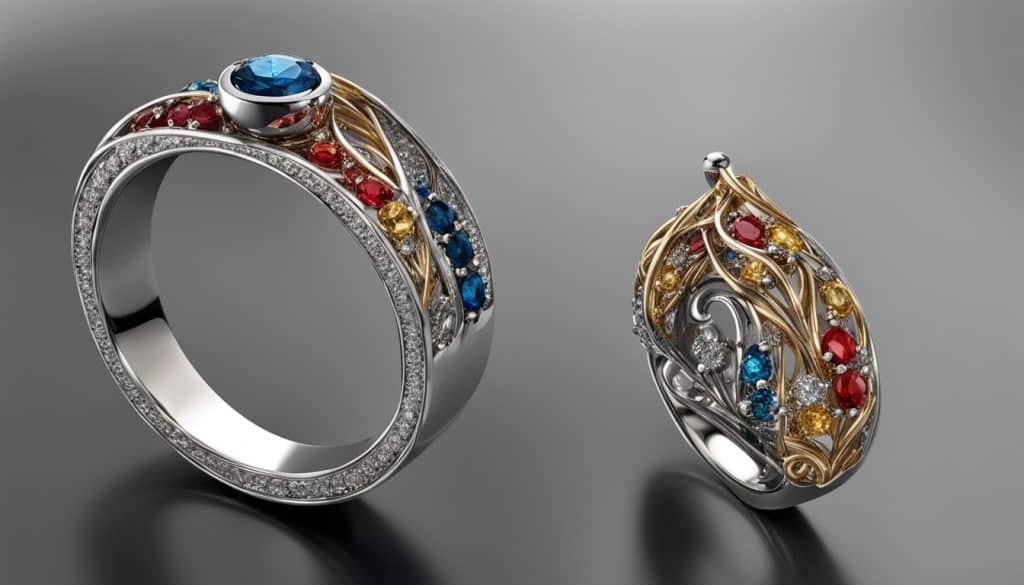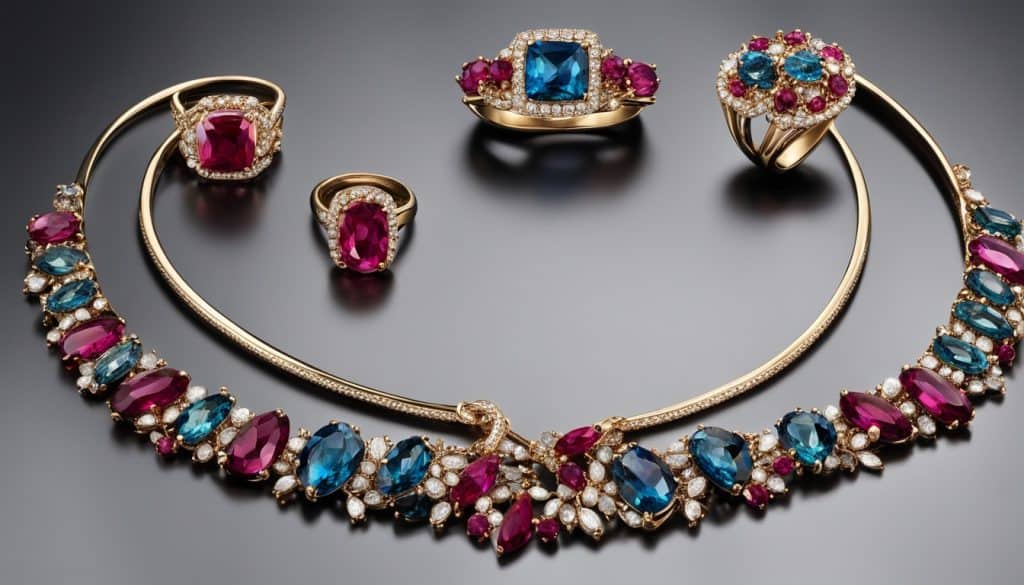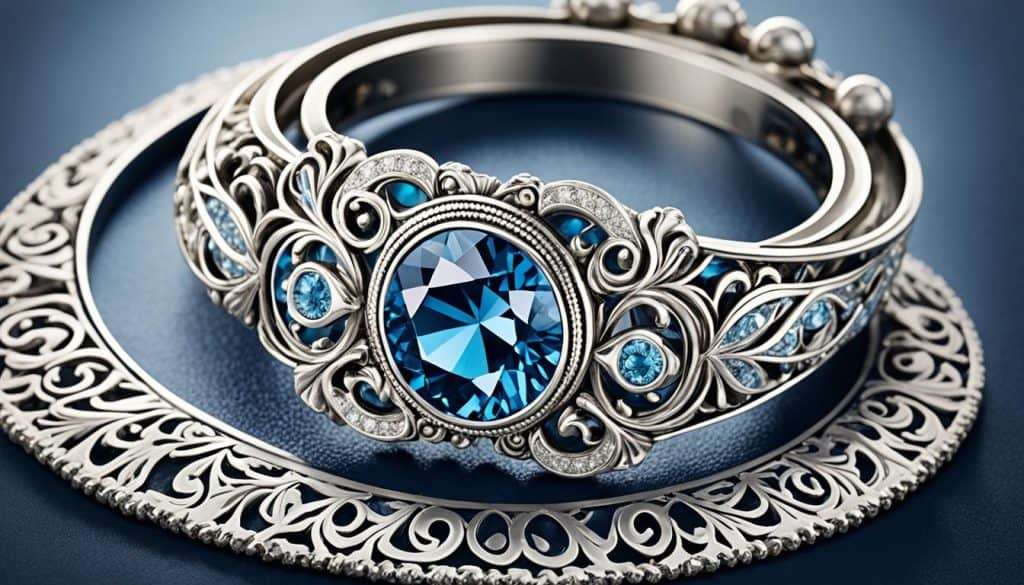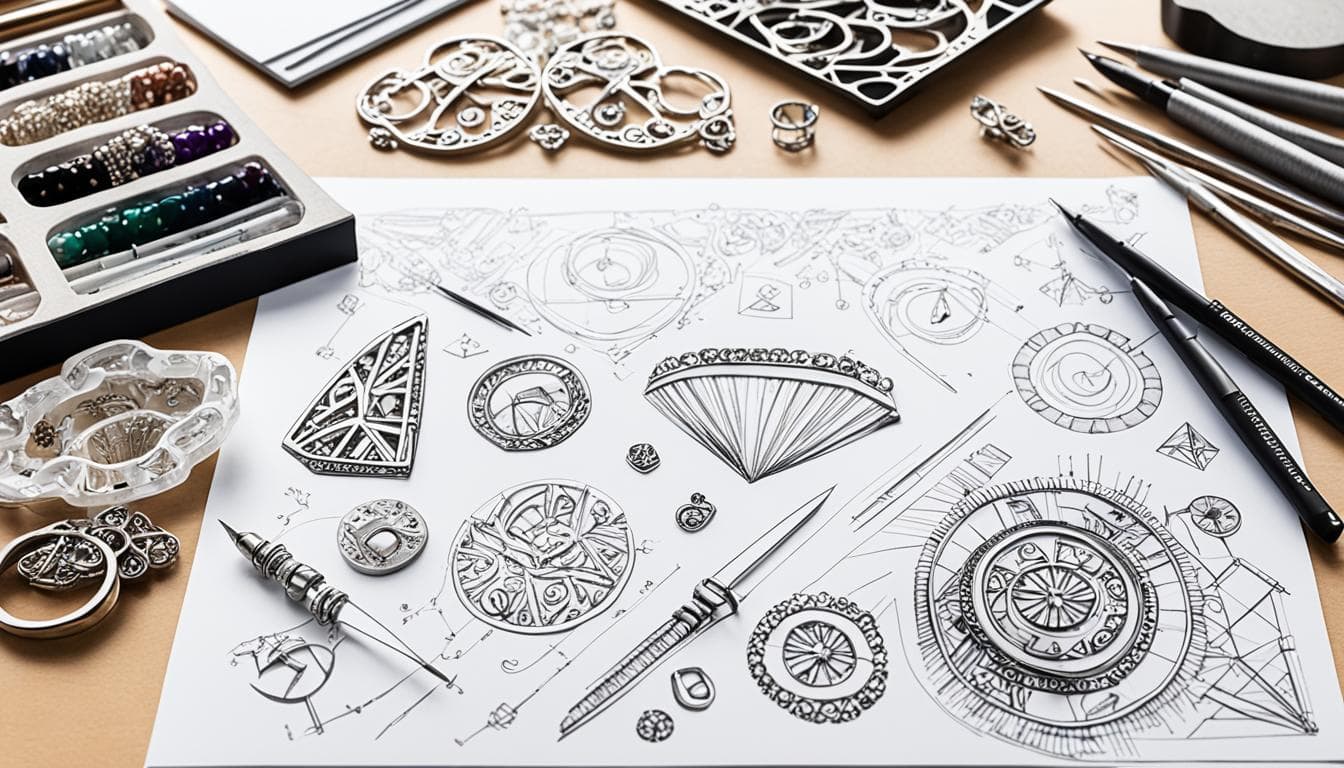I still remember the day my grandmother handed me a small velvet box. Inside, a delicate necklace with shimmering gemstones sparkled in the sunlight. It was more than jewelry; it was a gift full of love, heritage, and timeless beauty.
Jewelry has always been special, captivating us with its beauty and craftsmanship. Ever wondered what makes these pieces so captivating?
In jewelry design, creativity shines. It’s an art that needs an eye for beauty and a commitment to making things by hand. I invite you to learn about the principles of jewelry design. We’ll look at balance, contrast, and more.
Let’s dive into the world of jewelry design together. We’ll discover the secrets of its lasting beauty. We’ll explore the principles, history, and emotional value of jewelry. Are you ready for this sparkling journey?
Finding Equilibrium: The Role of Balance in Jewelry Design
Balance is key in jewelry design. It means spreading out the visual weight of a piece carefully. This makes the jewelry look good and feel right.
There are three main types of balance in jewelry: symmetric, asymmetric, and radial. Each type has its own way of making a piece look balanced.
Symmetric balance means putting elements on either side of a central point. This makes the design stable and formal. For example, a necklace with a pendant in the middle, flanked by smaller beads, uses symmetric balance.
Asymmetric balance uses different elements to create a balanced look. It doesn’t need mirror images. A necklace with a big stone on one side and smaller ones on the other is an example. This type of balance makes the design interesting.
Radial balance uses elements in a circle or spiral around a central point. This is often seen in designs with a big stone in the middle, surrounded by smaller ones. It adds movement to the piece.
Balance in jewelry isn’t just about symmetry or asymmetry. It’s also about how the elements weigh visually. Each part of a piece adds to its balance, based on its size and where it’s placed.

When making jewelry, think about how stable and balanced the elements are. This makes sure the jewelry looks good and feels comfortable to wear. Problems like clasps coming undone or earrings hanging wrong often come from poor balance.
“Issues like stones falling out, strings breaking, or finishes flaking off show how important choosing the right materials and techniques is.”
A balanced piece of jewelry looks great and feels good to wear. Designers should think about how their designs support themselves. This includes things like rings, loops, and hinges that help with movement.
Again, pay attention to keeping the image interval consistent with the previous paragraph.
“Improving stability in jewelry might mean adjusting lengths, making things slope inward, and spreading out weight and stress for better use.”
Understanding balance and visual weight helps designers make jewelry that looks amazing and lasts. Finding balance is a mix of art and practicality. This results in jewelry that’s both beautiful and functional.
Harmonizing Size: Proportion in Jewelry Design
Proportion is key in jewelry design. It means making sure each part fits well together. This makes the jewelry look good and feel comfortable to wear.
In jewelry design, proportion is vital for balance. It makes sure no part stands out too much. For example, a necklace’s pendant should match the chain’s size. This makes the necklace look good and feel right on the neck.
Designers think about size, shape, and weight when they plan jewelry. They pick and arrange parts carefully. This makes the jewelry stand out and be easy to wear. A well-proportioned piece looks good from all angles.

Proportion is not just about size. It’s also about how parts work together. Designers balance gemstones, metals, and details. This makes the jewelry look good and feel comfortable.
Proportion matters in all jewelry, from tiny earrings to big necklaces. It keeps each piece feeling whole and balanced. By focusing on size, designers make jewelry that looks great and feels good to wear.
Making a Statement: The Power of Contrast in Jewelry Design
Contrast is key in jewelry design. It uses color, texture, and shape differences to grab attention and make a bold statement. Designers mix contrasting elements to create unique and captivating pieces.
Color is a big part of contrast in jewelry. It’s the most important design element, catching the eye and adding beauty. Designers learn about color to pick the right ones for their pieces. This choice makes their designs stand out.
Texture adds to the contrast too. Beads and materials change how colors look and move. Depending on the angle and light, colors can shift. Mixing smooth metal with rough diamonds creates a striking contrast that boosts the design’s look.
Shape also brings contrast to jewelry. Different shapes add depth and interest. Combining geometric and organic shapes makes the piece more intriguing.
Contrast grabs attention and adds movement to jewelry. It helps designers share their message and make their designs more appealing.
Jewelry artists must think about where their pieces will be worn. The setting changes how people see colors and contrasts. Designers need to pick their elements carefully for the best look.
Knowing how color relates to other design elements is crucial. It’s not just about color theories. It’s also about how people react, the design process, and the setting.
Designers use contrast to share their vision and add depth to their work. Contrasting elements help define parts, add structure, play with light, and change how jewelry interacts with the wearer or setting.
Contrast in jewelry design makes pieces stand out. By using contrasting elements wisely, designers can make a bold statement and be noticed in a crowd.
Creating Cohesion: The Importance of Unity in Jewelry Design
Unity in jewelry design is key to making pieces that look great together. It makes the jewelry stand out. By using the same materials, colors, and shapes, jewelry makers can make something beautiful and balanced.
Unity means finding similarities between different parts of a piece. Using the same materials, like gold and diamonds, makes a design look connected. This creates a look that’s both elegant and unified.
Colors also play a big part in unity. Matching colors, like gemstones in a bracelet and earrings, brings everything together. This makes each part of the jewelry work as one complete piece.
Shapes matter too. Using shapes that go well together, like geometric or organic ones, adds to the unity. This makes the jewelry look good and balanced.
Unity is very important in jewelry design. It makes a big impact and catches the eye. It makes sure all parts of the jewelry work together, creating something beautiful and balanced.

Historical Inspiration and Personal Style: Guiding Concepts of Unity
When making jewelry, there are many things that can help with unity. Historical designs, modern trends, and personal style are all important. They help guide the design choices.
Looking at historical jewelry can give ideas for unity. By studying past styles, artists can use elements that fit their look. This adds a historical touch to the design.
Modern trends also offer new ways to think about unity. By looking at current fashion and design, artists can add new elements. Yet, they can still keep the design balanced and harmonious.
Personal style is also key to unity. Adding one’s own artistic vision and preferences makes the jewelry unique. This creates a piece that shows the artist’s style and unity.
In the end, unity in jewelry design comes from thinking about materials, colors, shapes, and inspiration. By focusing on unity, artists make jewelry that catches the eye and looks timeless.
Flowing Elegance: Harmony and Movement in Jewelry Design
Harmony and movement are key in jewelry design. They add depth and visual interest. They make the design look elegant and captivating.
Harmony means combining different design elements like color, shape, texture, and line well. It’s about finding the right balance. This creates a pleasing look.
Imagine a necklace with different gemstones that match well in color and shape. This makes the piece look unified and elegant.
Movement in jewelry design means making the piece flow or move in a certain way. It guides the eye and adds energy. This is done by arranging elements in a specific way.
A necklace with smaller pieces from the center to the sides has movement. This design draws the eye to the center while flowing nicely.
Harmony and movement together make jewelry designs captivating. They boost the look and make a piece stand out. Designers use colors, textures, shapes, and flow to create these effects.
Trends change, but harmony and movement stay key in jewelry design. These principles make each piece elegant and graceful. They turn jewelry into a treasured art piece.
Crafting Timeless Beauty: The Art of Jewelry Design
Jewelry design is a captivating art that blends creativity, skill, and knowledge of beauty. Designers use balance, proportion, and other principles to make pieces that look good and feel meaningful. This process mixes imagination with technical skill, creating art that lasts.
Traditional jewelry honors the past with its classic techniques and patterns. It connects us to our cultural heritage and history. At the same time, modern designs break new ground with innovative methods and materials. They appeal to those who want unique and bold pieces.
There’s a jewelry style for everyone, from ethnic to minimalist, and avant-garde. Each style has its own unique beauty and story. They all add to the world of jewelry art, making it rich and diverse.
